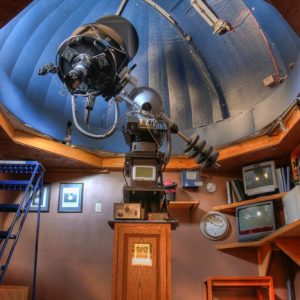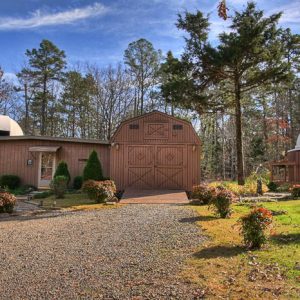calsfoundation@cals.org
Arkansas Sky Observatories
Arkansas Sky Observatories (ASO) is a network of four observatories that conduct studies of near Earth asteroids (NEOs), objects that pose a danger of impact at some point to planet Earth. ASO began in 1971, located on the south brow of Petit Jean Mountain. ASO was one of the first five contributing observatories to the Harvard-Smithsonian Center for Astrophysics network and continues to be a major contributor to the Harvard Minor Planet Center today. This relationship has resulted in more than 50,000 contributed orbital measurements of comets and asteroids.
ASO was established by P. Clay Sherrod and his brother, Brian Sherrod. P. Clay Sherrod has authored seventeen books in astronomy, archaeology, and the environmental/biological sciences, and has patented numerous inventions and processes in the fields of space, environmental, and biological sciences, as well as alternative energy. The observatories were privately established and funded to provide an outlet into space and astronomical sciences. They continue to operate privately but contribute to numerous agencies and professional organizations worldwide.
The location of the first observatory atop Petit Jean Mountain allows it to be in dark (though ever brightening) skies; the Arkansas River wraps around the northwest side of the mountain, which makes the location ideal for stargazing because it forces the earth’s blanket of air up, which reduces the heat waves that the telescope sees.
In 1971, black-and-white photos were taken, developed, scaled, and plotted to known stars in the universe to plot the location of particular asteroids and comets followed by ASO. Communications of discoveries and observations to the Harvard-Smithsonian Observatory in Cambridge, Massachusetts, were done either over a rotary-dial telephone or by actual telegram if urgency dictated. This process could easily take several hours to complete; today, with the addition of modern technology at the observatories, the same data can be gathered and transmitted in a matter of seconds.
ASO Petit Jean Mountain (Harvard/MPC H45) is just one of four of the ASO operating locations in Arkansas. Harvard/MPC H43 (1997) is located outside of western Conway (Faulkner County), while a robotic telescope is now in operation at Harvard/MPC H44 (2003) at Cascade Mountain, north of Vilonia (Faulkner County), an observatory operated by Brian Sherrod. A second Petit Jean Mountain observatory, designated as H41, was constructed in 2005 and maintains state-of-the-art equipment and computer/video/digital data-gathering capability.
Data is gathered by computerized telescopes and downloaded to a dozen computers that are coupled together to calculate precise locations of NEOs and comets. This data is so precise that it can see the point of a pin thirty-three miles away as it would appear to the naked eye. Data can then be plotted to give the direction, speed, and present orbit for any object being tracked.
ASO Petit Jean Mountain is one of 300 Harvard-designated astrometry measurement observatories in the world and currently ranks twelfth in the United States on the number of observations, surpassed only by the largest professional astrometric observatories. In 1975, there were eighty-three observatories gathering information for the Harvard Minor Planet Center, while in 2011 there are more than 300 observatories, few of which make more than a dozen observations per year. In the case of Petit Jean Mountain ASO facilities, the observations for the year 2010 alone numbered in excess of 5,500.
Today, ASO serves as the oldest privately funded observatory still active in research and outreach in Arkansas, boasting cutting-edge astronomical equipment privately designed and custom built for the ASO research and educational protocols. In addition to pure scientific research, community outreach has been a primary focus of ASO. The ASO website today is one of the world’s most visited space resources. ASO annually contributes significant science equipment to schools in impoverished or rural districts across the United States as part of its educational outreach mission. The observatory maintains its status as a contributor or “fellow” of the National Aeronautics and Space Administration (NASA) Jet Propulsion Laboratory (planets); Tokyo Observatory; Oriental Astronomical Association; Yale University; Harvard-Smithsonian; University of Arizona Lunar and Planetary Laboratory, Tucson; British Astronomical Association; and many other scientific associations.
For additional information:
Arkansas Sky Observatories. http://www.arksky.org/ (accessed February 7, 2022).
Sherrod, Clay. “Arkansas Sky Observatories’ Installation and Use of the Planewave CDK-17.” Astronomy Technology Today (July 2009): 41–43.
P. Clay Sherrod
Arkansas Sky Observatories







Comments
No comments on this entry yet.